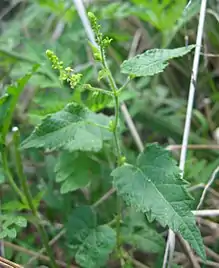| Tragia cordata | |
|---|---|
 | |
| Scientific classification | |
| Kingdom: | Plantae |
| Clade: | Tracheophytes |
| Clade: | Angiosperms |
| Clade: | Eudicots |
| Clade: | Rosids |
| Order: | Malpighiales |
| Family: | Euphorbiaceae |
| Genus: | Tragia |
| Species: | T. cordata |
| Binomial name | |
| Tragia cordata | |
Tragia cordata, commonly called the heartleaf noseburn,[1] is a species of herbaceous plant in the spurge family. It is native to North America, where it is found in scattered in the southeastern United States.[2] Its natural habitat is in rocky calcareous woodlands and prairies.[3]
This species is notable for its intensely painful stinging hairs.[4] It is readily distinguished from other Tragia in the east by its vining habit and large heart-shaped leaves.[3][5] It produces small green flowers in the summer and early fall.[4][5]
References
- ↑ USDA, NRCS (n.d.). "Tragia cordata". The PLANTS Database (plants.usda.gov). Greensboro, North Carolina: National Plant Data Team. Retrieved 18 December 2017.
- ↑ "Tragia cordata". County-level distribution map from the North American Plant Atlas (NAPA). Biota of North America Program (BONAP). 2014. Retrieved 18 December 2017.
- 1 2 Alan Weakley (2015). "Flora of the Southern and Mid-Atlantic States".
- 1 2 MissouriPlants
- 1 2 Flora of North America, Tragia cordata
This article is issued from Wikipedia. The text is licensed under Creative Commons - Attribution - Sharealike. Additional terms may apply for the media files.